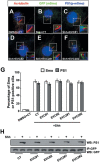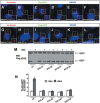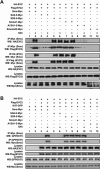Smoothened transduces Hedgehog signal by forming a complex with Evc/Evc2
- PMID: 22986504
- PMCID: PMC3494391
- DOI: 10.1038/cr.2012.134
Smoothened transduces Hedgehog signal by forming a complex with Evc/Evc2
Abstract
Hedgehog (Hh) signaling plays pivotal roles in embryonic development and adult tissue homeostasis in species ranging from Drosophila to mammals. The Hh signal is transduced by Smoothened (Smo), a seven-transmembrane protein related to G protein coupled receptors. Despite a conserved mechanism by which Hh activates Smo in Drosophila and mammals, how mammalian Hh signal is transduced from Smo to the Gli transcription factors is poorly understood. Here, we provide evidence that two ciliary proteins, Evc and Evc2, the products of human disease genes responsible for the Ellis-van Creveld syndrome, act downstream of Smo to transduce the Hh signal. We found that loss of Evc/Evc2 does not affect Sonic Hedgehog-induced Smo phosphorylation and ciliary localization but impedes Hh pathway activation mediated by constitutively active forms of Smo. Evc/Evc2 are dispensable for the constitutive Gli activity in Sufu(-/-) cells, suggesting that Evc/Evc2 act upstream of Sufu to promote Gli activation. Furthermore, we demonstrated that Hh stimulates binding of Evc/Evc2 to Smo depending on phosphorylation of the Smo C-terminal intracellular tail and that the binding is abolished in Kif3a(-/-) cilium-deficient cells. We propose that Hh activates Smo by inducing its phosphorylation, which recruits Evc/Evc2 to activate Gli proteins by antagonizing Sufu in the primary cilia.
Figures







Similar articles
-
The ciliary Evc/Evc2 complex interacts with Smo and controls Hedgehog pathway activity in chondrocytes by regulating Sufu/Gli3 dissociation and Gli3 trafficking in primary cilia.Hum Mol Genet. 2013 Jan 1;22(1):124-39. doi: 10.1093/hmg/dds409. Epub 2012 Oct 1. Hum Mol Genet. 2013. PMID: 23026747
-
A Smoothened-Evc2 complex transduces the Hedgehog signal at primary cilia.Dev Cell. 2012 Oct 16;23(4):823-35. doi: 10.1016/j.devcel.2012.07.004. Epub 2012 Sep 13. Dev Cell. 2012. PMID: 22981989 Free PMC article.
-
EFCAB7 and IQCE regulate hedgehog signaling by tethering the EVC-EVC2 complex to the base of primary cilia.Dev Cell. 2014 Mar 10;28(5):483-96. doi: 10.1016/j.devcel.2014.01.021. Epub 2014 Feb 27. Dev Cell. 2014. PMID: 24582806 Free PMC article.
-
Ellis-van Creveld syndrome and Weyers acrodental dysostosis are caused by cilia-mediated diminished response to hedgehog ligands.Am J Med Genet C Semin Med Genet. 2009 Nov 15;151C(4):341-51. doi: 10.1002/ajmg.c.30226. Am J Med Genet C Semin Med Genet. 2009. PMID: 19876929 Review.
-
Role of primary cilia and Hedgehog signaling in craniofacial features of Ellis-van Creveld syndrome.Am J Med Genet C Semin Med Genet. 2022 Mar;190(1):36-46. doi: 10.1002/ajmg.c.31969. Epub 2022 Apr 8. Am J Med Genet C Semin Med Genet. 2022. PMID: 35393766 Review.
Cited by
-
Bifurcating action of Smoothened in Hedgehog signaling is mediated by Dlg5.Genes Dev. 2015 Feb 1;29(3):262-76. doi: 10.1101/gad.252676.114. Genes Dev. 2015. PMID: 25644602 Free PMC article.
-
Hedgehog Signaling and Truncated GLI1 in Cancer.Cells. 2020 Sep 17;9(9):2114. doi: 10.3390/cells9092114. Cells. 2020. PMID: 32957513 Free PMC article. Review.
-
Hedgehog Signaling: Implications in Cancers and Viral Infections.Int J Mol Sci. 2021 Jan 21;22(3):1042. doi: 10.3390/ijms22031042. Int J Mol Sci. 2021. PMID: 33494284 Free PMC article. Review.
-
Epigenetic priming of neural progenitors by Notch enhances Sonic hedgehog signaling and establishes gliogenic competence.bioRxiv [Preprint]. 2025 Jan 21:2025.01.20.633996. doi: 10.1101/2025.01.20.633996. bioRxiv. 2025. Update in: Genes Dev. 2025 Jul 1;39(13-14):886-906. doi: 10.1101/gad.352555.124. PMID: 39896669 Free PMC article. Updated. Preprint.
-
Germline and Mosaic Variants in PRKACA and PRKACB Cause a Multiple Congenital Malformation Syndrome.Am J Hum Genet. 2020 Nov 5;107(5):977-988. doi: 10.1016/j.ajhg.2020.09.005. Epub 2020 Oct 14. Am J Hum Genet. 2020. PMID: 33058759 Free PMC article.
References
-
- Ingham PW, McMahon AP. Hedgehog signaling in animal development: paradigms and principles. Genes Dev. 2001;15:3059–3087. - PubMed
-
- Nusslein-Volhard C, Wieschaus E. Mutations affecting segment number and polarity in Drosophila. Nature. 1980;287:795–801. - PubMed
-
- Jiang J. Regulation of Hh/Gli signaling by dual ubiquitin pathways. Cell Cycle. 2006;5:2457–2463. - PubMed
Publication types
MeSH terms
Substances
Grants and funding
LinkOut - more resources
Full Text Sources
Other Literature Sources
Molecular Biology Databases
Miscellaneous

